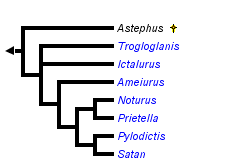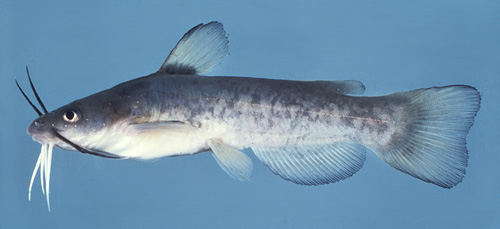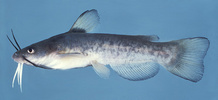Ictaluridae
North American Freshwater Catfishes, Bullhead Catfishes
Larry Page and John G. Lundberg


This tree diagram shows the relationships between several groups of organisms.
The root of the current tree connects the organisms featured in this tree to their containing group and the rest of the Tree of Life. The basal branching point in the tree represents the ancestor of the other groups in the tree. This ancestor diversified over time into several descendent subgroups, which are represented as internal nodes and terminal taxa to the right.

You can click on the root to travel down the Tree of Life all the way to the root of all Life, and you can click on the names of descendent subgroups to travel up the Tree of Life all the way to individual species.
For more information on ToL tree formatting, please see Interpreting the Tree or Classification. To learn more about phylogenetic trees, please visit our Phylogenetic Biology pages.
close boxIntroduction
With 48 species, Ictaluridae, the Bullhead Catfish family, is the largest family of freshwater fishes endemic to North America. Bullhead catfishes are easy to recognize from other North American freshwater fishes. They have no scales, 4 pairs of barbels ("whiskers") around the mouth, an adipose fin, stout spines at the dorsal and pectoral fin origins (except some cave species), and pelvic fins on the abdomen. Members of this family are active mainly at night in contrast to the other large groups of North American freshwater fishes–minnows, darters, and suckers–which are primarily active during daylight. Glandular cells in the skin surrounding the fin spines of some species, especially madtoms, contain venom, and a person can be "stung" by a catfish. Reaction to the sting of a madtom varies with the individual but is generally considered equivalent to a bee sting.
The Flathead and Blue Catfishes, the giants of the family at about 132 lb. (60 kg) and over 5 ft. (1.5 m) in length, and several other large species, especially the widely marketed Channel Catfish, are of major commercial, angling, and aquacultural value.
Ictalurids are organized into 7 genera:
- Ictalurus, with 7 species, including the familiar Channel Catfish.
- Ameiurus, with 7 species including the Yellow, Black and Brown Bullheads.
- Noturus, containing 29 small species known as madtoms.
- Pylodictis, containing only the Flathead Catfish.
- Satan and Trogloglanis, each containing 1 species of cave-inhabiting species in Texas.
- Prietella, containing 2 species of cave-inhabiting species in Mexico.
About This Page
Larry Page

Florida Museum of Natural History, Gainesville, Florida, USA
John G. Lundberg

The Academy of Natural Sciences, Philadelphia, Pennsylvania, USA
Correspondence regarding this page should be directed to Larry Page at and John G. Lundberg at
Page copyright © 2006 Larry Page and John G. Lundberg
All Rights Reserved.
- First online 23 May 2007
- Content changed 23 May 2007
Citing this page:
Page, Larry and John G. Lundberg. 2007. Ictaluridae. North American Freshwater Catfishes, Bullhead Catfishes. Version 23 May 2007 (under construction). http://tolweb.org/Ictaluridae/15230/2007.05.23 in The Tree of Life Web Project, http://tolweb.org/








 Go to quick links
Go to quick search
Go to navigation for this section of the ToL site
Go to detailed links for the ToL site
Go to quick links
Go to quick search
Go to navigation for this section of the ToL site
Go to detailed links for the ToL site